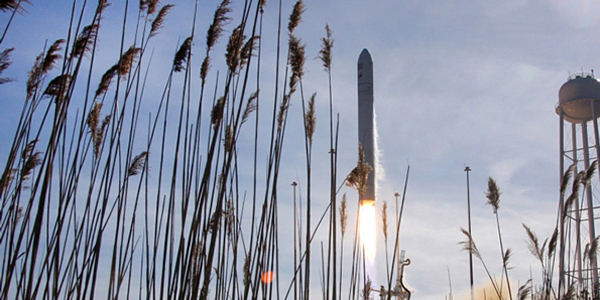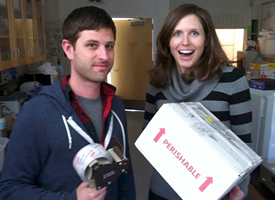NC State Ants Boldly Go Into Space

When NC State postdoc Clint Penick collected a group of pavement ants in a small mountain community in Western North Carolina last summer, he never dreamed they’d travel farther than his biology lab in Raleigh. Today, as they orbit the earth in the International Space Station 265 miles above sea level, the 600 ants from Spruce Pine are having the adventure of a lifetime.
It’s the kind of story you’d expect from a Hollywood animation studio. A poor colony of ants, living under a rock in a struggling mining town are plucked from obscurity and drafted into the U.S. space program. Within months they’re blasting off from NASA’s Wallops Flight Facility in eastern Virginia in an unmanned rocket named – appropriately enough – Antares. Once inside the space station, the ants are free to float about their habitat under the watchful gaze of scientists.
“It’s amazing,” says Penick. “It was totally random.”

As luck would have it, ants are hard to find in the winter. So when researchers at the Baylor College of Medicine got the green light from NASA last December to place an ant experiment on the International Space Station, they put out feelers in the scientific community.
Eleanor Spicer Rice, a science writer who earned her Ph.D. in entomology at NC State, passed word to Penick, who was just finishing up a set of lab experiments with the ants he collected in Spruce Pine.
“It was all very secretive,” Penick says. “NASA needed ants and they were going into space. That’s all I knew.”
Ants in Space
The researcher, it turns out, had the right stuff for the project. Pavement ants, or Tetramorium caespitum, are one of the most common species of ants in American cities. That makes them perfect for a citizen science project like the space station experiment.
Here’s how it works. The project encourages elementary classrooms all over the country to monitor the ants on the space station via a video feed while conducting similar experiments of their own. By comparing the ants in space with their cousins here on earth, school kids can document how zero gravity affects ants as they explore their habitats.

Although NC State isn’t a research partner in this project, the university is a pioneer in the field of citizen science. Biology professor Rob Dunn, who leads the lab where Penick conducts his research, spearheads a number of projects that enlist citizen volunteers – both children and adults – to collect insect samples.
Penick, who earned his Ph.D. at Arizona State University, came to NC State to pursue his passion for researching ants. He works with Dunn on the “School of Ants,” a citizen science project that is building a database of the world’s 12,000+ species. Pavement ants are among the most fascinating, he says.
“They compete and they’re highly territorial,” he says. “They’re sidewalk fighters. Every year in the spring they come out and reestablish their territorial boundaries and so you’ll see thousands of ants fighting each other and grappling and literally tearing each other apart.”
But research into ants doesn’t just focus on war and conflict. Researchers have studied the collective intelligence of ants and even developed ant-based algorithms to help route airplanes through busy airports.
“I’m fascinated by their social behavior,” Penick says. “Even though they’re really simple organisms when they’re alone, when you put them in a group and they start interacting, they’re capable of doing these completely amazing feats.”
- Categories:


